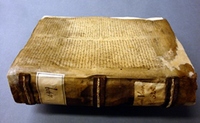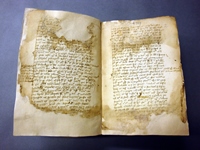Conservation of a 15th century limp binding
|
This Latin codex from the Collection of Manuscripts and Rare Books of the Austrian National Library is entitled „Quaestiones in IV Sententiarum“. The book block contains 153 pages on subjects like tabulae systematics, theology and dogmatics. It is dated to the period between 1400 and 1499. The manuscript was bound as a limp parchment binding. The link-stich sewing passes through the centre of the sections, the back of the parchment cover and three leather strips. In the centre of the sections strips from earlier parchment manuscripts were included. A flexible parchment binding was an inexpensive variation compared to a book bound in leather over rigid covers, analogous to today’s paperbacks. The binding’s parchment was cockled and showed several creases. It was partially severely degraded and brittle showing tide lines and losses. The sewing was also damaged. Several sections were loose and the link-stitches on the spine of the book were partially torn. The text block’s paper was severely degraded by microorganisms as a result of an earlier water damage. At the beginning and the end of the text block the sheets are discoloured and disintegrated in the head and tail areas, making them illegible. Some sheets show large losses and tears along the edges. A fragment of the first page was adhering to the inside of the book’s cover. The limp binding offered less protection to the content of the book than a rigid binding. The aim of the conservation treatment was to inhibit further damage by a local disinfection, consolidation and the filling of losses. Furthermore, the loose sections should be joined back to the book block without dismantling the original sewing. The limp binding should be preserved as a historic book cover. The partial re-stitching and addition of link-stitches were executed with a dyed cotton thread. After this stabilisation of the book block, the sheets were locally disinfected with 70% ethanol. Losses in the text block were filled with Japanese tissue and dislocated fragments were replaced in their original position. Losses in the parchment cover were filled with a specially produced material. It consists of a blend of parchment dust, parchment glue and cellulose fibres. This material was used dry to fill losses and gaps in the parchment. The described conservation interventions allowed to preserve the original binding of the manuscript. At the same time, the function of the codex is recovered: the book can be opened and read. |

_200x150.jpg)

200x150.jpg)

